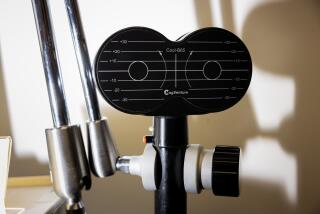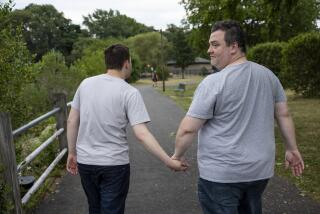Science / Medicine : With safeguards, this controversial procedure is the best way to treat depression, say doctors. : Shock Therapy Makes Comeback
- Share via
Fifty years after its introduction--and five years after voters in Berkeley tried to ban it--there are still few controversies in psychiatry more polarizing than the question of whether electricity should be used to induce seizures to treat depression.
Critics of electroconvulsive therapy (ECT) say that, even when used properly, it causes brain damage and works only by confusing patients so they can’t remember why they were depressed.
But ECT proponents, chiefly psychiatrists, say that shock treatments are the single most effective way to help people with major depression, that side effects are minimal and that the public has been frightened by irresponsible scare stories.
The reality may be more complex than either position indicates. And the controversy is likely to heat up again now that ECT may be making a comeback.
Recent studies suggest that ECT’s effects begin to take hold quickly but do not last very long and that, while there is no evidence that it causes structural brain damage, patients often do experience some permanent memory loss.
Researchers are having only limited success fine-tuning the electric shock so as to produce therapeutic benefit without harmful side effects.
Prime candidates for ECT are people suffering from major depression, which is generally characterized by hopelessness and guilt. These people are barely able to function and often suicidal.
The treatment of choice for major depression is any of several types of antidepressant drugs. Normally, only patients who do not respond to drug therapy receive shock treatments.
ECT consists of a brief jolt from a specially designed machine that induces an epileptic-style seizure of 30 to 60 seconds. A patient typically gets two or three treatments a week for two to four weeks.
No one can explain with any certainty why ECT relieves depression, but some researchers speculate that the answer lies in the brain’s response to a seizure.
Because of the mental condition of most ECT candidates, critics question whether practitioners obtain meaningful consent from such patients. “The main issue is: Are the patients given enough information so they can make an informed decision?” says Dr. Lee Coleman, a Berkeley psychiatrist who supported that city’s 1982 referendum to ban ECT.
Indeed, the chapter on ECT to appear in next year’s American Psychiatric Assn. Handbook, written by Dr. Charles Welch, director of the ECT service at Massachusetts General Hospital in Boston, warns: “A significant number of patients are either too inert to carry out meaningful consent, or oppose treatment because of negativistic or paranoid ideation that is part of their depressive illness.”
In the 1940s and ‘50s, psychiatrists now acknowledge, the treatment was given too often and without much regard to diagnosis. It was painful, and the convulsions sometimes caused broken bones.
As depicted in movies and books such as “One Flew Over the Cuckoo’s Nest” and “The Bell Jar,” ECT seemed a brutal punishment more than a form of therapy. Today it is administered under anesthesia, with muscle relaxants and oxygen to make the experience less traumatic.
The use of shock therapy declined rapidly in the 1950s as antidepressant and anti-psychotic medication became available. Also, statutory regulations, bad press and malpractice insurance have led to its virtual disappearance from state hospitals.
Today, while it is still not about to overtake antidepressants as the remedy of first resort, ECT seems to be making a comeback in private and university hospitals.
“There’s more of a feeling that the treatment is acceptable than there was five years ago,” says Dr. Richard Weiner, a psychiatrist at Duke University Medical School. “It’s known to work quickly in an age where you have to get the patient in and out of the hospital before the coverage runs out.”
A national survey in 1980 indicated that about 33,000 people received ECT that year--most of them middle-aged or elderly and almost two-thirds of them women. While some believe that the total number has risen slightly since then, no one knows for sure.
Although some critics remain unconvinced, ECT’s effectiveness with seriously depressed patients is widely accepted among psychiatrists today. “People aren’t even doing efficacy studies any more,” says Dr. Ed Coffey, a colleague of Weiner’s at Duke. “The idea that it doesn’t work is laughable.”
One reason for ECT’s recrudescence is that its reputation for working quickly makes for relatively low-cost care. A study by New York psychiatrist John Markowitz and his colleagues published last August claimed that, of patients who are hospitalized, those treated with ECT were out of the hospital 13 days sooner than those given certain antidepressant medication--amounting to an average saving of $6,405 per person per stay.
Other new research has suggested that ECT may also benefit manic patients, whose psychotic symptoms include frenzied activity and euphoria. In the most significant study with manic patients to date, Joyce Small and Iver Small, professors of psychiatry at Indiana University Medical Center, showed “90% or better results” with 50 people suffering from manic psychoses.
But regardless of what it is used for, shock therapy is “an acute treatment--it gets a patient out of a bad spot,” Iver Small says. “It’s not going to hold for more than three to six weeks.”
One woman, for example, describes how ECT “lifted a biochemical cloud from my brain” and let her return to graduate school.
But the effects of the treatment can subside, leaving patients self-absorbed, unable to concentrate, overwhelmed by the everyday frustrations of life.
Specialists generally assume that the beneficial effects of ECT will wear off after a few months for about half of all patients. They also believe that this relapse rate can be reduced to 10% to 20% if medication is given after a course of shock therapy.
But Harold Sackeim, a psychologist at Columbia University and a leading researcher in the field, points out that most patients who get ECT are resistant to drugs in the first place. Based on preliminary results from his current research, he says, “our feeling is that standard practice doesn’t work.”
Critics have also been unable to substantiate their charges of irreversible brain damage. Coffey, in a study just submitted for publication, scanned patients’ brains with a technique called magnetic resonance imaging and found “no structural effects of the treatment.”
Nevertheless, patients do seem to lose a chunk of memory, and the effect increases with each shock. “We have fair reason to believe that with respect to events around the (time of) ECT, there will be a permanent loss of memory,” Sackeim says.
This can mean anything from having more difficulty remembering names to losing whole intervals of one’s life. Annette Schwartz, a 49-year-old former kindergarten teacher who received ECT treatment in Washington in the spring and summer of 1986, says the period between March and October of that year is now a complete blank to her.
More disturbing, though, is the fact that her ability to remember new information has been impaired. “I hear something on TV or read something now, and I just can’t recall it a minute afterwards,” she said. “I was so highly organized,, and now I start something and can’t complete it. I have lists and I lose them.”
While some patients report no such side effects, it is clear that Schwartz is by no means alone. A 1980 British survey found that three-quarters of ECT patients complained of memory loss--and 30% said the loss was permanent.
In a 1983 follow-up survey of 31 patients by Larry Squire, a psychologist at San Diego’s Veterans Administration Medical Center, half the respondents reported some amnesia. The memory loss was primarily confined to a period beginning six months before the ECT and ending two months after it.
But amnesia can be markedly reduced by administering the shock to just one side of the brain--usually the right side, which is the non-dominant one for most people. “Unilateral” ECT requires far less electricity and, in the majority of studies, has proven just as effective as the bilateral type. Many patients report no memory loss at all after receiving unilateral ECT.
Even ECT’s most respected researchers--including Drs. Sackeim, Squire, and Weiner--agree, however, that bilateral is still used by a majority of practitioners nationwide even though unilateral is generally the treatment of choice.
Yet, confining the shock to one side of the brain may not be enough. “The thing that troubles me is not just the use of bilateral but the use of high dosages,” Sackeim said. Because the amount of electricity required to induce a seizure varies so widely depending on the individual, he says, some patients are getting 20 or 30 times the current they need.
Newer ECT machines, using a brief pulse of electricity, are generally believed to cause fewer side effects since they produce a seizure with one-third the energy of a conventional “sine-wave” machine that relies on standard house current.
Even this effect may be short-lived, however. A 1986 study by Squire and Joyce Zouzounis showed that the memory-related advantages of brief-pulse ECT lasted about an hour. When asked to recall bits of prose and diagrams six to 10 hours later, subjects didn’t perform any better than those receiving sine-wave ECT.
More bad news was published in November in a study of 52 patients by Sackeim and his colleagues. Giving these subjects the bare minimum unilateral shock necessary for a seizure--so as to reduce memory loss--failed to produce any reduction of depression.
The question, says University of British Columbia psychologist and epilepsy specialist John Pinel, is: “Do the possibilities of a brief remission of depression justify the risks of interfering with a patient’s memory?”
The answer, say ECT proponents, is usually yes, given the high mortality rate of seriously depressed patients. Some commit suicide while others fail to eat or care for themselves.
“The alternative to ECT is to have all these elderly patients on (your) hands without being able to treat them,” says Dr. Welch.
Alfie Kohn, a contributing editor at Psychology Today, is the author of “No Contest: The Case Against Competition . “






